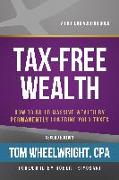- Start
- Tax-Free Wealth
Tax-Free Wealth
Angebote / Angebote:
After 31 years... Major Tax Reform- and what it means to youTrue overhaul of the tax law only happens about once every 30 years. In thepast 75 years, the U.S. tax law has only seen three major revisions, one in 1954, the next in 1986 and most recently at the end of 2017. I have been fortunate asa tax professional to be heavily involved in the last two reforms.In 1986, I was a manager in the National Tax Department (NTD) ofErnst & Whinney (now Ernst Young). My primary responsibility during mythree years there was to create, teach and administer tax courses to the Firm'sU.S. tax professionals. Just as I arrived in the summer of 1985, I discoveredthat much of NTD's resources were being devoted to following the tax reformbill that had been introduced that year.This gave me, as a young tax professional, some amazing insight into thelegislative process as well as the horse trading for tax reform. President Reaganwanted two things, simplicity (the 1985 act was call the Tax SimplificationAct of 1985) and he wanted it to be revenue neutral (no net increase to thedeficit). It took another year before bill was finally passed as the Tax ReformAct of 1986. (Simplicity took a back seat to other goals of the reform.)In 1986 the big winners from tax reform were individuals, with significantlylower tax rates, insurance companies (who got by relatively unscathed)and businesses. The big loser was real estate investors (the passive loss ruleswere used as a last-ditch effort to make a "revenue-neutral" bill. The result afew years later was the Savings and Loan debacle accompanied by a massivereal estate depression and the government bailing out real estate throughthe RTC (Resolution Trust Corporation).Fast forward 31 years to 2017. President Trump had promised economicstimulus and had stumbled out of the blocks with the failure to repealObamaCare. Everyone thought tax reform would take two years to completelike it had in 1985-1986. Instead, the Republican-controlled Congress wasable to use slick procedural rules to pass major tax reform in record time (lessthan three months from start to finish).The result was a bill the consequences of which and application of whichare still largely unknown. Known are the clear winners and losers. Losersinclude employees with lost deductions for moving, investment expensesand reductions in home mortgage interest and state income tax deductions.Winners include big corporations, with a major tax reduction from 35% tobig corporations, with a major tax reduction from 35% to21%, small businesses, with a 20% net income deduction, and real estate, withmajor depreciation incentives and the 20% net income deduction given toother small businesses.The key to remember is that very few people had the chance to influencethis legislation. Everyone has the same chance to take advantage of the windfallsgiven to the winners. Employees can choose to be independent contractorsand receive the 20% small business deduction. Service professionals who wereleft out of the 20% deduction can now become C corporations and reducetheir tax rate to 21%. Investors who received tax benefits from the costs ofinvesting in the stock market can either begin investing in real estate, with itsmassive tax benefits, or invest through their Roth IRA or Roth 401(k) andavoid tax altogether on the income and gains from their investments.Tax-Free Wealth is about using the tax law the way it's meant to be used- as a series of incentives to do what the government wants you to do. ThisSecond Edition incorporates some ideas of how to use the new incentives. Thereality is that the incentives don't really change that much. The governmentstill wants businesses to hire employees, so businesses receive tax benefitsfor doing so. The government still wants investors to provide housing forrenters (even more so now), so real estate investors receive large tax breaks forfollowing through on the government's goals. Energy is still favored, bothtraditional energy (oil & gas and coal) and renewable energy (wind, solar andhydroelectric).For U.S. taxpayers, you will find helpful tips in this new edition to helpyou apply the new tax incentives to your situation. As a bonus, I have includedinformation and a link to a free eBook that you can download detailing theTop Ten Tax Benefits from the Trump Tax Reform. For you who live outsidethe United States, and no matter what country you live in, this edition shouldhelp you look for ways to apply your government's incentives. You may evendecide that now is the time to do business in the United States as that country.is, to some degree, a tax haven.You can take advantage of the tax incentives offered by your governmentonly if you understand how the tax law works. Every day, you have theopportunity to reduce your taxes. Once you have digested this book, take itto your tax advisor and have them read it (or better yet, buy them their owncopy). Then your tax advisor, who is responsible for understanding all of thetechnical details of the law, can help you apply them to your specific situation.Enjoy this book and let me know what you think. You can always reachme at team@wealthability.com. Here is to your Tax-Free Wealth.
Lieferbar in 24 Stunden
